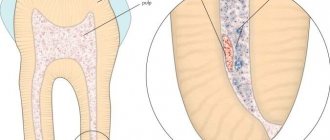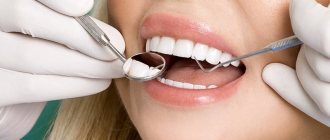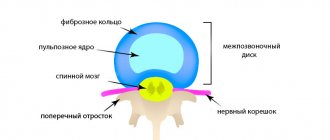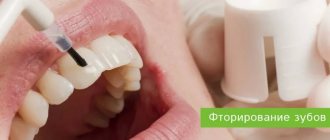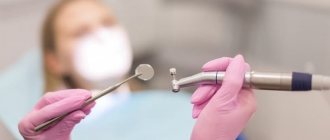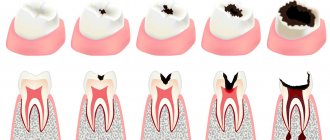home
Therapeutic dentistry
Treatment of caries
Have you noticed stains on the enamel or has your tooth begun to react to hot and cold?
All these are signs of tissue demineralization and caries development! Many people, faced with such symptoms, put off visiting a doctor until they become seriously ill. This approach does not solve the problem at all; even a slight damage to the enamel requires immediate treatment, otherwise it will result in tooth loss.
Do you want a 10% discount on treatment?
Make an appointment now!
I WANT A 10% DISCOUNT
At the PROFI-Dent clinic in Moscow, dental caries treatment is carried out quickly, efficiently and completely painlessly. If you do not want to face the procedure of dentures in the future, you need to see a doctor as soon as possible!
Stages of caries
- Initial (superficial, in the stain stage) - a white or brown round-shaped spot forms on the enamel. There is no pain or discomfort. The defect can only be noticed visually. A light color indicates an acute process, and a dark color indicates a chronic one.
- Medium (dentin damage) - the infection eats away the enamel, spreads to the dentin, and forms a cavity in it. Slight pain occurs when biting or applying heat to the tooth. The edges of the cavity are sharp and periodically crumble.
- Deep - the infection reaches the pulp, the tooth begins to disturb constantly, especially at night. The pain is intensified by temperature irritants and sweets. The attacks are strong, but short (last 5-10 seconds).
It is impossible to accurately determine the degree of caries by eye. The degree of damage can be diagnosed only by drilling the tooth. Often, externally, the lesion looks medium, but turns out to be deep, so only the estimated price of therapy is discussed with the doctor in advance.
Contraindications
- Acute stage of ARVI, acute respiratory infections, herpetic rashes
- I, III trimester of pregnancy
- Acute stage of periodontal disease
- Bruxism (night grinding of teeth)
- Seizure attacks
Indications
- Darkening of tooth cusps, cervical areas
- Chipping of a piece of tooth enamel
- Dark gap along the border of the filling
- “Dots”, “spots” on teeth
- Pain from sweet, sour, cold
Causes of caries
According to statistics, caries treatment in Moscow is carried out daily for tens of thousands of patients. And this is not surprising, because dental diseases are second only to colds in terms of prevalence in the world.
Scientists name different reasons for the development of caries. These include poor oral hygiene, lack of vitamins and minerals in the diet, and low immunity. But one of the main factors that, in fact, triggers the carious process is the consumption of sugar-containing foods. In this case, the following processes occur:
- the number of cariogenic bacteria in the oral cavity increases many times;
- pathogenic microorganisms ferment sugar, resulting in the formation of acid;
- Tooth enamel dissolves or demineralizes under acidic influence.
Thus, every time a person consumes “empty” carbohydrates or sugar, he feeds the caries bacteria. They form plaque on the enamel. It is in these areas that, under the influence of acid, first the enamel and then the dentin are destroyed.
Diagnostics
In our clinic, caries diagnosis begins with an examination. The dentist carefully examines each tooth from the outside and inside, lightly tapping it (percussion). If a source of infection is detected, thermometry is performed - exposing the tooth to cold to assess the reaction. Electroodontometry helps determine the degree of infection development - the impact of a microcurrent on the tooth, to which the inflamed pulp will react. Patients are prescribed x-rays to assess the condition of the root tissues and detect hidden cavities.
Non-invasive treatment
Dentistry is one of the most rapidly developing branches of medicine. Previously, doctors used exclusively invasive treatment methods, which were the main cause of dental phobia, i.e. fear of visiting the dental office.
This fear is dangerous because patients with this phobia put off visiting the dentist until the last moment, which leads to caries and its relapses, chronic gum inflammation, periodontitis and other diseases.
Non-invasive methods help overcome this fear, which is why they are actively used in the dental community. Medical in South Butovo uses the most modern methods of caries treatment, which reduce patient discomfort to a minimum. The choice of technique depends on the specific clinical case and the patient’s health condition.
All dentists at the center are recognized professionals with many years of successful practice experience. We managed to assemble a team where every employee is interested in the result and works conscientiously. A list of dentists in our center can be found below.
Stages of traditional caries treatment (using a drill)
- Anesthesia completely removes pain. At DHC, local anesthesia is performed with new generation drugs based on Articaine. The injections are completely safe, hypoallergenic, and have no restrictions or side effects.
- Tooth preparation - excision of carious tissues with a drill. It is necessary to remove all affected tissue, otherwise the infection will recur.
- Creation of a cavity with burs of different sizes with cooling so as not to overheat the pulp and dentin. Inside, the cavity is treated with etching gel to improve adhesion to the filling.
- Installation of a gasket - made on the basis of calcium hydroxide, normalizes blood circulation in the pulp, accelerates dentin regeneration. Spacers are needed when the cavity wall is located next to the pulp.
- Filling with photopolymer materials. Such fillings are durable, similar in color to enamel, and can withstand any load.
- Grinding - adjusting the filling height so that it does not interfere with the closure of the teeth and does not disturb the bite.
Minimally invasive as an innovative treatment method
Made possible by advances in dentistry, minimally invasive therapy involves diagnosing caries in its early stages combined with preparation techniques that leave as much of the healthy (intact) tooth structure as possible intact. The advent of innovations in dental technology and materials designed to detect early stages of caries, coupled with equipment and instruments that minimize tissue destruction during dental procedures, has led to the emergence of techniques that emphasize preserving as much intact tissue as possible. The concept of Minimal Invasive Dentistry (MID) - minimally invasive dentistry, or, as it is also called, Microdentistry - microdentistry, offers a new standard of treatment that preserves as much healthy dental tissue as possible and reduces the risk of tooth decay in the future.
This concept was introduced in June 2000 with the opening of the first annual conference of the International Congress of Minimally Invasive Dentistry (WCMID) in Skaneateles Falls, New York, USA, where more than one hundred participants from 13 countries gathered to introduce and popularize the techniques of the new paradigm . In this regard, new organizations have emerged, such as the Academy of Minimally Invasive Dentistry (ACAMID), new Internet portals and publications to inform professionals and the public about the benefits of microdentistry. Inspired practicing dentists around the world began to actively introduce and research new techniques, and manufacturers began to offer the most suitable equipment and materials for this concept.
Dr. Joseph Whitehouse, current president of WCMID, notes that the key to MID is the preparation method and soon all dentists will abandon the traditional rules of Black cavity preparation in favor of minimally invasive procedures.
The concept of air abrasion is recognized as the most promising method for removing necrotic areas of tooth tissue in comparison with such as chemical and air-water abrasion, ultrasonic, laser and instrumental preparation due to the absolute safety, efficiency and cost-effectiveness of the proposed systems. Its essence lies in the use of abrasive aluminum oxide powder (Al2O3) with the necessary kinetic energy through air pressure.
Among the air abrasive devices offered by manufacturers, the most effective Sandman Futura system (Denmark) should be noted.
The system is based on a unique patented vortex atomization principle, which provides precise and controlled delivery of the required amount of specially granulated powder at low air pressure, which is regulated by a foot pedal. Can be used for patients of all ages: children, adults and the elderly.
Compared to classical methods of cavity preparation, there are a number of advantages of using air abrasion:
- When treating all types of caries (even deep ones!), anesthesia is not required, since there is no vibration or pressure on the tooth tissue, and as a result, there is no mechanical irritation that causes a pain reaction.
- Tooth tissues are removed smoothly and strictly sequentially, and the process itself is visible to the naked eye of the attending physician, which minimizes the risk of penetration into the pulp chamber.
- There is no psychological pressure on the patient, since there is no sound of the drill and no smell of dentin, and self-treatment is almost silent.
- The preparation speed is 2–3 times higher than that of a drill, which depends on the skills of the dentist.
- There is no risk of hypothermia or overheating of the pulp.
- Absolutely harmless to surrounding tissues.
- The quality of surface treatment is very high, since the walls of the cavity after treatment have a rough surface, which increases the adhesive ability of filling materials. European statistics do not know a single case of secondary caries after filling a cavity treated with Sandman Futura.
In addition to preparing and treating cavities, modern dentists can use Sandman Futura more widely:
- Preparation of cavities and fissures (cleaning and preparation before endodontic treatment).
- Roughening of enamel and dentin to improve adhesion.
- Preparation of metals and composites to improve the quality of surface adhesion.
- Preparation of ceramics before silanization.
- Removal of old fillings, amalgam and residues of composites, bondings and cements, including orthodontic ones.
- Aggressive removal of stains and plaque.
- Delicate removal of ceramic inlays and restorations.
- Preparation of surfaces for bracket systems, including lingual ones.
- Providing endodontic access through composites, porcelain or metal ceramics.
- Treatment of fluorosis.
- Removing amalgam tattoo from dentin and enamel.
- Cleaning polymer clamping tools from polymer seals, corrosion, etc.
- Reduces glare on instruments used under intense microscope light.
Clinical use of Sandman Futura for the treatment of deep caries
At the Faculty of Dentistry of the University of Copenhagen, professors Edvina Kid (London, England), Svend Cerlsen (Faaborg, Denmark) and histologist Lars Bjorndal (Copenhagen, Denmark) conducted clinical studies for 10 years, consisting of treatment with minimal intervention: gradual removal of carious dentin and fillings using the Sandman Futura air abrasive unit and observing long-term results. Only complete abrasion of the marginal zones was performed, leaving the decalcified, discolored and possibly infected soft and destroyed tissues in the deep part of the cavity intact.
The following selection criteria were used:
- The area affected by caries had to be of such depth and size that there would be a risk of perforation using traditional preparation techniques.
- The tooth had to be alive.
- The nature of the pain corresponded to the classics of deep caries, both acute and chronic forms.
- No changes in periapical tissues.
- The destruction must be so extensive that sequential/gradual filling cannot be continued for at least 12 months.
- The marginal gingival zone should be subgingival, which in most cases was achieved using periodontal manipulations performed using precision precision instruments.
- The observation period was to range from 12 to 24 months.
- During the examination and before further manipulation, the tooth must be asymptomatic for at least 7-8 months, tests and x-rays must confirm their normal vital signs.
- No age criteria
Methodology:
- X-ray diagnostics.
- The principles of sequential (delayed) treatment were explained to the patient and his consent was obtained.
- In 50% of cases, no anesthesia was performed (given the painless preparation method with the Sandman Futura device); in other cases, ligamentous anesthesia was performed using Sleeper One.
- In 50% of cases, gum retraction was performed.
- Flexidam was installed.
- If necessary, the previous filling was removed, and sharp chipped edges of the enamel were removed.
- The cavity was stained using a caries detector.
- The entire 2 mm wide periphery is completely cleaned using a Sandman machine using 25 micron powder at a pressure of 1.9 atm at a distance of 1 mm from the tooth.
- The cavity itself is partially cleaned using Sandman 452 micron powder at a pressure of 1.9 atm until the bottom of the cavity acquires a natural color.
- Depending on the width Vz, this process can last up to 3 minutes.
- Polyacrylic acid is used for cleaning, which is then washed off with plenty of water; then the cavity is dried.
- The desired type of matrix is installed (Walzer matryx).
- Fuji2LC is used for gentle filling without creating air pockets.
- The filling is polished.
- Flexidam is removed.
- A bite check is performed.
- The patient is instructed to return for a follow-up visit if hyperemia or spontaneous pain occurs.
- The patient is asked to return in 12 months for a check-up including X-ray, EDI and routine treatment.
Subsequently, a small number of therapeutic measures were carried out on teeth susceptible to spontaneous pain, with an expected poor prognosis (initial, acute pulpitis teeth).
Results:
As stated above, the treatment measures carried out were selected according to clear criteria, and more than 1,300 consecutive fillings were performed.
1. A small number (up to 50 teeth) have hypersensitivity, especially those teeth that have undergone gum retraction.
2. After completing the course of treatment, two teeth were depulped.
3. Four teeth were removed.
4. Root canals were treated on 15 teeth during the observation period.
Conclusions:
Minimally invasive treatment using the Sandman Futura air abrasion system fully meets modern requirements for approaching the problem of caries and allows for the addition and constant improvement of techniques.
The main advantages of using air abrasion compared to traditional preparation methods for dentists:
- Makes the treatment procedure faster, easier and more controlled.
- Better long-term results due to maximum preservation of healthy dental substances and minimization of factors that adversely affect tooth tissue, such as heat and vibration.
- Expanding the practice by improving the image of the clinic and staff, as well as attracting new categories of patients, such as children, pregnant women and allergy sufferers. Minimizing costs for consumables.
- New horizons for professional progress are opening up.
Benefits for patients:
- Painless treatment.
- Treatment is carried out in an atmosphere of psychological comfort (absence of irritants such as drilling, vibration, specific sound and smell).
- Minimal time costs – high-speed tooth treatment without anesthesia. Treatment takes half as much time.
- Best quality – minimal intervention dentistry means optimal treatment while preserving tooth structure.
- Longer warranty thanks to advanced technology.
Non-invasive methods for caries treatment (without drilling)
- Ozone therapy helps in the initial stages. Carious tissues are not removed mechanically; they are only treated for disinfection with ozone, which destroys 99.9% of bacteria. The procedure completely stops the development of the infection.
- ICON - infiltration of infection at the spot stage. The drug penetrates damaged enamel and makes it durable. The tooth surface becomes resistant to bacteria and organic acids.
- Laser therapy is similar to traditional therapy and is effective at all stages. It differs in that damaged tissue is not drilled out, but evaporated by a laser.
- Sandblasting (air abrasive) treatment is indicated for the treatment of initial caries. The sandblasting machine has the same principle of operation as a drill, but without vibration and contact effects on the enamel.
Icon treatment - indications and contraindications
When the infiltration technique appeared, many experts called the technology a small dental miracle, since it became possible to do without a drill. However, non-invasive caries treatment Icon is effective only in certain cases.
Indications
- The initial type of caries with depths E1, E2, D1 (where E1 is external damage to the enamel, D1 is one-third damage to dentin). However, some experts still do not recommend treating caries with Icon at a depth of D1.
- Dentophobia, fear of local anesthesia.
- Chalk spots after orthodontic treatment (removal of braces).
- Initial caries in hard-to-reach areas (especially in the interdental spaces).
Contraindications
- Treatment of caries without an Icon drill cannot be carried out in the advanced form of the disease, which has affected more than one third of the dentin.
- Cannot be used to combat enamel diseases (erosion, hypoplasia, etc.).
- The technology is contraindicated for the treatment of children under three years of age due to the presence of components that can damage overly sensitive enamel.
- In case of individual allergic reactions to materials and components.
Complications after treatment
If the dentist overheats the dentin or injures the pulp during preparation, the tooth will begin to ache after the anesthesia wears off. We'll have to re-open it and depulp it. A lump may appear on the gum after unsuccessful canal sealing if the material penetrates beyond the root. Then you need to re-open the canal, treat the inflammation, then fill it again.
If the filling is in the way, it means that the dentist did not sharpen or polish it properly. This can be easily fixed. The appearance of a reaction to thermal changes indicates a violation of the tightness of the seal. All these complications often arise due to the fault of the dentist. To prevent them, you should carefully choose a clinic and trust only doctors with extensive experience.
Stages of tooth treatment without drilling
Treatment of superficial caries with ICON does not last long: approximately half an hour. In addition, the technology does not imply any special preparation: in the absence of the above contraindications, the procedure is carried out in one go.
So, let's list the stages:
- thoroughly clean the teeth and oral cavity, be sure to dry it;
- To highlight the working area and protect the remaining teeth, carefully install interdental wedges;
- Gently apply the etching gel for about a couple of minutes.
- wash off the gel;
- We thoroughly dry the teeth using intense air pressure and Icon-Dry conditioner;
- We apply the infiltrate in two stages;
- We illuminate it with ultraviolet light (the duration of the first stage of illumination is 3 minutes, and in the second stage 1 minute will be enough).
Preventive measures
The risk of developing dental caries cannot be completely eliminated. However, following certain medical recommendations can reduce the likelihood of tissue damage. Among them:
- high-quality and regular teeth cleaning. Not only the surface of the teeth, but also the tongue and cheeks should be cleaned of plaque;
- rinse your mouth after every meal. For these purposes, it is preferable to use special rinses;
- flossing after meals;
- balanced diet;
- giving up bad habits - smoking, drinking alcohol;
- reducing or eliminating the consumption of coffee and sweets;
- Regular visits to the dentist - at least once every 6 months.
By following these rules, you can significantly reduce the risk of rapid development of caries and tooth loss. After completing caries treatment, the patient must carefully monitor the condition of the oral cavity and adhere to all the dentist’s recommendations.
Certificates
See all
Impeccable reputation
Numerous reviews from grateful VivaDent patients confirm the professionalism of our doctors
